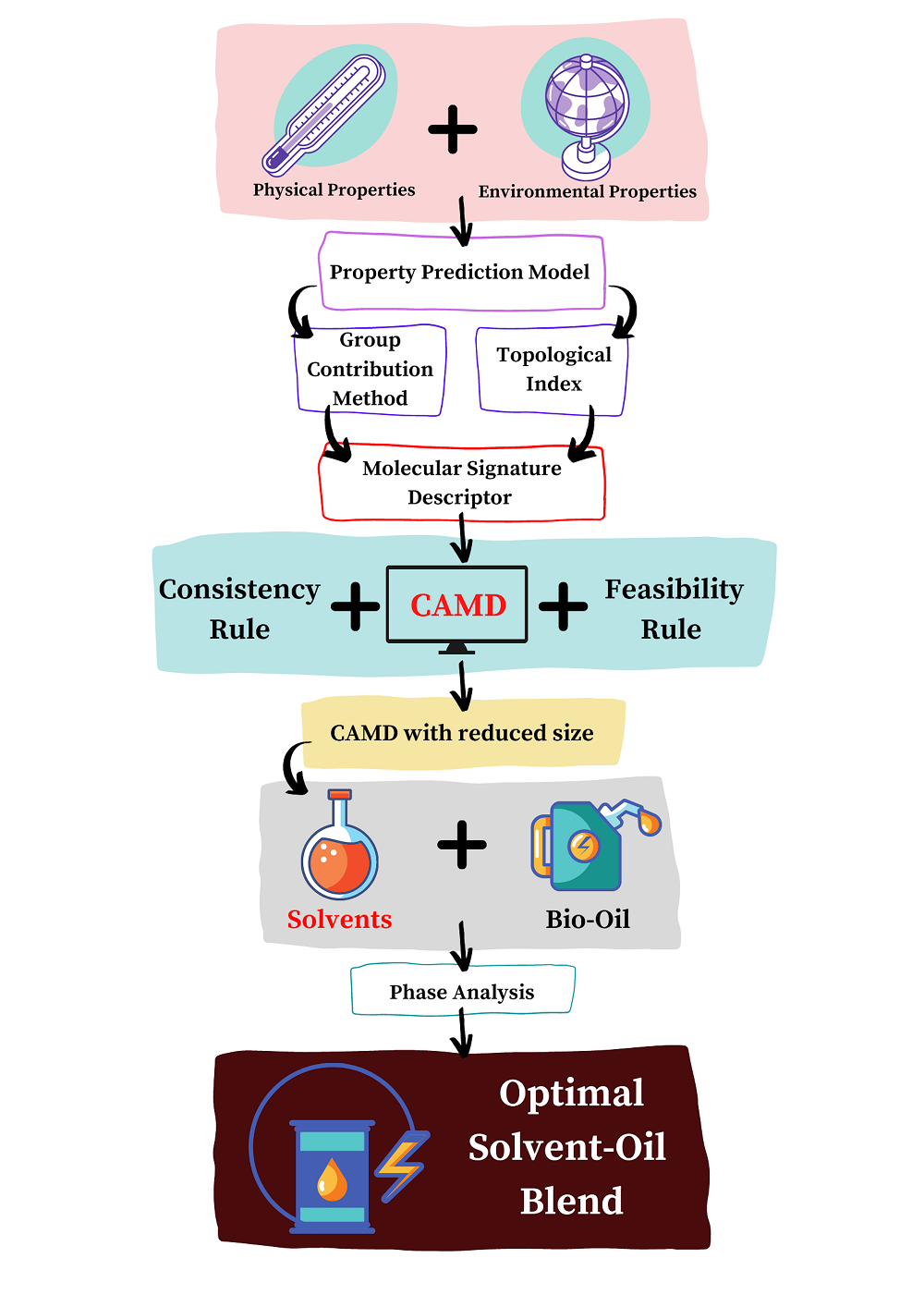1 Introduction
2 Experimental
2.1 Step 1: problem definition
2.2 Property prediction models
2.3 Step 2: CAMD formulation
2.3.1 Feasibility rules
Tab.1 Free bond groups in terms of signature of height 2 |
| Group | Description | Example |
|---|---|---|
| I | Bonding atom is a heteroatom bonded to a hydrogen atom | O1(C2(CO)) |
| II | Bonding atom is a heteroatom bonded to a carbon atom | O2(C2(CO)C3(CCO)) |
| III | Bonding atom is a carbon atom bonded to a heteroatom, which is bonded to a hydrogen atom | C2(O1(C)C2(CC)) |
| IV | Bonding atom is a carbon atom bonded to a heteroatom, which is bonded to a carbon atom | C2(O2(CC)C2(CC)) |
| V | Bonding atom is a carbon atom bonded to another carbon atom | C2(C2(CC)C3(CCC)) |
Tab.2 Allowed combination of groups |
| Group | I | II | III | IV | V |
|---|---|---|---|---|---|
| I | × | × | × | × | √ |
| II | × | × | × | √ | √ |
| III | × | × | √ | √ | √ |
| IV | × | √ | √ | √ | √ |
| V | √ | √ | √ | √ | √ |
2.3.2 Structural constraints
Tab.3 Mathematical expression for structural constraints |
| Rule | Structural constraint | Equation |
|---|---|---|
| I | (13) | |
| II | (14) |
2.3.3 Consistency rules
Tab.4 Set of signatures for 2-octanol with its corresponding height 2 signatures |
| No. | Height 3 signature | Corresponding height 2 signature |
|---|---|---|
| 1 | C1(C3(C1(C)C2(CC)O1(C))) | C1(C3(CCO) |
| 2 | C1(C2(C1(C)C2(CC)) | C1(C2(CC)) |
| 3 | C2(C1(C2(CC))C2(C2(CC)C2(CC))) | C2(C1(C)C2(CC)) |
| 4 | C2(C2(C1(C)C2(CC))C2(C2(CC)C2(CC))) | C2(C2(CC)C2(CC)) |
| 5 | C2(C2(C2(CC)C2(CC))C2(C2(CC)C2(CC))) | C2(C2(CC)C2(CC)) |
| 6 | C2(C2(C2(CC)C2(CC))C2(C2(CC)C3(CCO))) | C2(C2(CC)C2(CC)) |
| 7 | C2(C2(C2(CC)C2(CC))C3(C1(C)C2(CC)O1(C))) | C2(C2(CC)C3(CCO)) |
| 8 | C3(C1(C3(CCO))C2(C2(CC)C3(CCO))O1(C3(CCO))) | C3(C1(C)C2(CC)O1(C)) |
| 9 | O1(C3(C1(C)C2(CC)O1(C))) | O1(C3(CCO)) |
2.4 Step 3: verification
2.5 Step 4: miscibility analysis
3 Results and discussion
3.1 Defining target properties and constraints
Tab.5 Translation of product requirements into target properties and constraints |
| Requirement/need | Targeted property | Constraint | |
|---|---|---|---|
| Liquid state at room temperature | Normal boiling point/K | >400.15 | |
| Normal melting point/K | <298.15 | ||
| Fuel combustion quality | Higher heating value | To be maximised | |
| Fuel flow consistency | Viscosity/(mPa·s) | 1>>6 | |
| Density/(kg·m–3) | 800>>1000 | ||
| Homogenous form | Tangent plane distance | To be determined | |
| Environmental related properties and toxicology | Aquatic acute toxicity, LC50 | >100 | |
| Aquatic acute toxicity, EC50 | >100 | ||
| Oral acute toxicity, LD50 | >100 | ||
| Bioconcentration factor | <1000 | ||
| Soil-water partition coefficient/(L·kg–1) | <31622 | ||
| Global warming potential | <10 | ||
| Photochemical oxidation potential | <10 | ||
3.2 Selecting appropriate property prediction model
Tab.6 Example of 2nd order group expressed in terms of signature of height 2 or 3 |
| 2nd order group | Molecular signature |
|---|---|
| (CH3)2CH | C3(C1(C)C1(C)C2(CC)) |
| CH(CH3)CH(CH3) | C3(C1(C3(CCC)) C1(C3(CCC)) C3(C3(CCC)C1(C)C1(C)) |
| CH3COOCH | C4(C1(C4(=OOC) =O2(=C4(=OOC) O2(C4(=OOC)C2(CO))) |
3.3 CAMD formulations
Tab.7 Potential height 1, 2, 3 and 4 signatures generated |
| No. | Signature |
|---|---|
| Height 1 | |
| S1 | C1(C) |
| S4 | C2(CC) |
| S5 | C2(CO) |
| S11 | C3(CCO) |
| S22 | O1(C) |
| Height 2 | |
| D1 | C1(C3(CCO)) |
| D2 | C1(C2(CC)) |
| D4 | C2(C1(C)C2(CC)) |
| D7 | C2(C2(CC)C2(CC)) |
| D9 | C2(C2(CC)C3(CCO)) |
| D14 | C3(C1(C)C2(CC)O1(C)) |
| D17 | O1(C3(CCO)) |
| Height 3 | |
| T1 | C1(C3(C1(C)C2(CC)O1(C))) |
| T2 | C1(C2(C1(C)C2(CC))) |
| T4 | C2(C1(C2(CC))C2(C2(CC)C2(CC))) |
| T7 | C2(C2(C1(C)C2(CC))C2(C2(CC)C2(CC))) |
| T9 | C2(C2(C2(CC)C2(CC))C2(C2(CC)C2(CC))) |
| T10 | C2(C2(C2(CC)C2(CC))C2(C2(CC)C3(CCO))) |
| T12 | C2(C2(C2(CC)C2(CC))C3(C1(C)C2(CC)O1(C))) |
| T13 | C3(C1(C3(CCO))C2(C2(CC)C3(CCO))O1(C3(CCO))) |
| T14 | O1(C3(C1(C)C2(CC)O1(C))) |
| Height 4 | |
| Q1 | C1(C3(C1(C3(CCO))C2(C2(CC)C3(CCO))O1(C3(CCO)))) |
| Q2 | C1(C2(C1(C2(CC))C2(C2(CC)C2(CC)))) |
| Q3 | C2(C1(C2(C1(C)C2(CC))C2(C2(C1(C)C2(CC))C2(C2(CC)C2(CC)))) |
| Q7 | C2(C2(C1(C2(CC))C2(C2(CC)C2(CC)))C2(C2(C2(CC)C2(CC))C2(C2(CC)C2(CC)))) |
| Q12 | C2(C2(C2(C1(C)C2(CC))C2(C2(CC)C2(CC)))C2(C2(C2(CC)C2(CC))C2(C2(CC)C3(CCO)))) |
| Q15 | C2(C2(C2(C2(CC)C2(CC))C2(C2(CC)C2(CC)))C2(C2(C2(CC)C2(CC))C3(C1(C)C2(CC)O1(C)))) |
| Q18 | C2(C2(C2(C2(CC)C2(CC))C2(C2(CC)C3(CCO)))C3(C1(C3(CCO))C2(C2(CC)C3(CCO))O1(C3(CCO)))) |
| Q20 | C3(C1(C3(C1(C)C2(CC)O1(C)))C2(C2(C2(CC)C2(CC))C3(C1(C)C2(CC)O1(C)))O1(C3(C1(C)C2(CC)O1(C)))) |
| Q21 | O1(C3(C1(C3(CCO))C2(C2(CC)C3(CCO))O1(C3(CCO)))) |
Tab.8 Higher heating values obtained from NIST’s database and present work for respective solvent candidates |
| Molecular name | Higher heating value from NIST/(MJ·kg–1)[41] | Higher heating value/(MJ·kg–1) |
|---|---|---|
| 2-Octanol | 40.66 | 40.89 |
| 2-Heptanol | 39.72 | 40.00 |
| 2-Hexanol | 38.98 | 38.92 |
| 2-Pentanol | 37.72 | 37.50 |
Tab.9 The identified feasible solvent candidates |
| Molecular name | Formula | Molecular structure | Higher heating value/(MJ·kg–1) | Miscibility |
|---|---|---|---|---|
| 2-Octanol | CH3(CH2)5CH(OH)CH3 |  | 40.89 | Miscible |
| 2-Heptanol | CH3(CH2)4CH(OH)CH3 |  | 40.00 | Miscible |
| 2-Hexanol | CH3(CH2)3CH(OH)CH3 |  | 38.92 | Miscible |
| 2-Pentanol | CH3(CH2)2CH(OH)CH3 |  | 37.50 | Miscible |







